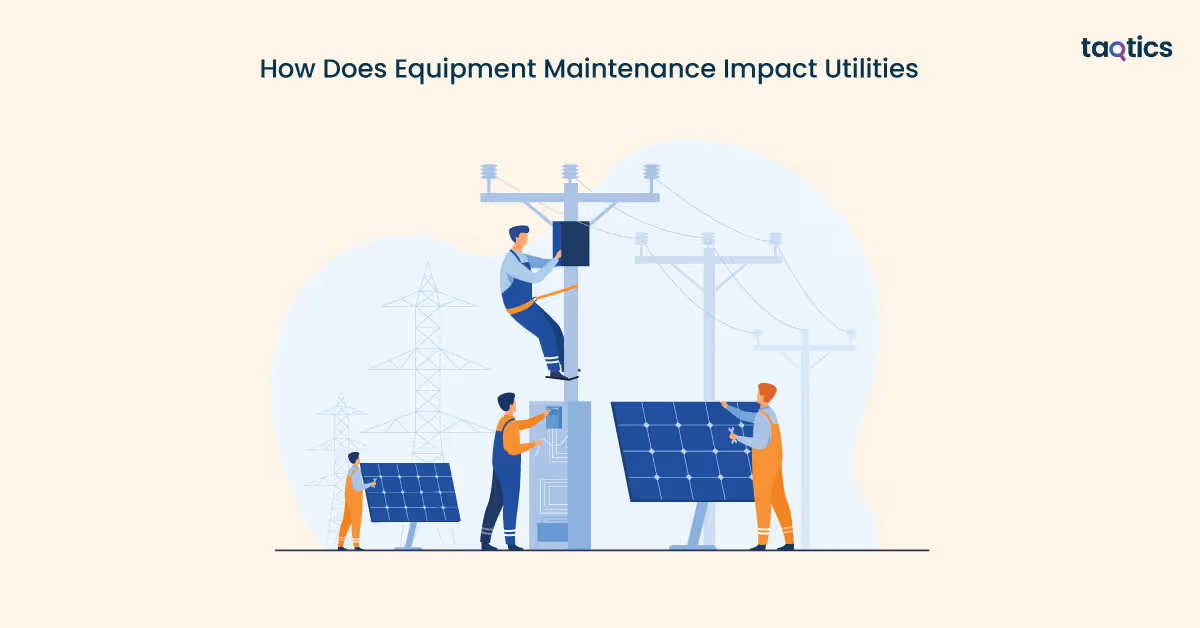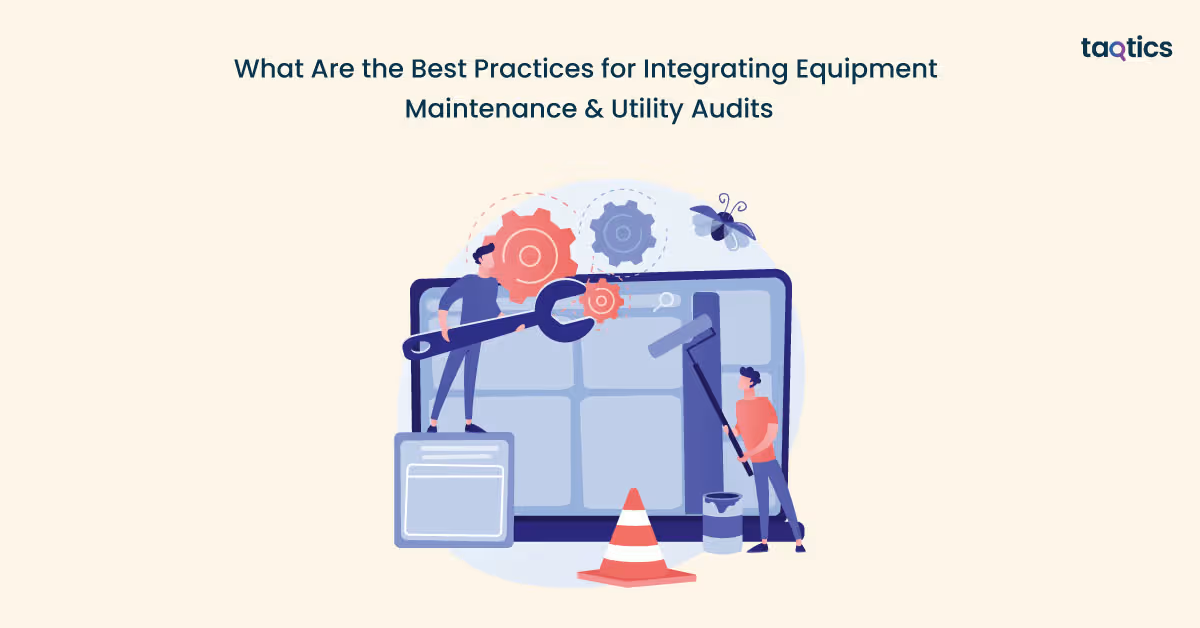Equipment Maintenance & Utility Audit: Definition, Key Areas Examined & How To Conduct

Equipment maintenance and utility audit evaluates the condition, efficiency, and safety of machines, utilities, and support systems used in operations. Equipment maintenance and utility audit helps organizations identify hidden inefficiencies, prevent costly breakdowns, and extend asset life. A simple everyday example is when you service your car regularly, checking brakes, oil, and battery, to avoid sudden breakdowns and ensure smooth performance. Similarly, factories, hospitals, or offices rely on audits to ensure their machinery, HVAC systems, or electrical utilities remain reliable and cost-effective.
The importance of such audits is underscored by research: according to a Deloitte report (2022), unplanned equipment downtime costs industrial manufacturers an estimated $50 billion annually, with 42% of downtime caused by equipment failure. Moreover, the International Energy Agency (IEA, 2021) notes that regular maintenance of utilities like HVAC systems can cut energy consumption by 10–30%, lowering operational costs significantly. This makes equipment and utility audits not just a compliance measure but a strategic investment in sustainability and productivity.
What Is Equipment Maintenance?
Equipment maintenance refers to the systematic process of ensuring that machinery, tools, and utilities operate safely, efficiently, and without unexpected failures. It includes various strategies designed to minimize downtime, extend equipment life, and reduce operational costs. Different industries adopt specific maintenance methods depending on equipment criticality, cost, and risk of failure.
Preventive Maintenance
Preventive maintenance involves performing scheduled checks and servicing at regular intervals regardless of the machine’s current condition. The goal is to avoid breakdowns before they occur. For example, lubricating bearings or replacing air filters on a set timeline. According to McKinsey (2021), preventive maintenance can lower repair costs by 12–18% compared to reactive approaches, highlighting its long-term financial benefits.
Predictive Maintenance
Predictive maintenance relies on real-time monitoring using sensors and analytics to anticipate failures before they happen. For instance, vibration analysis on motors can signal when parts are wearing out. A PwC report (2020) found that predictive maintenance reduces downtime by 30–50% and increases equipment life by 20–40%, making it one of the most cost-effective strategies for asset-heavy industries.
Corrective Maintenance
Corrective maintenance is the repair or replacement of equipment after a failure occurs. While sometimes unavoidable, it often results in costly downtime. The U.S. Department of Energy (DOE, 2020) notes that corrective-only maintenance can cost 2–5 times more than preventive or predictive strategies, due to unplanned disruptions and emergency repairs.
Condition-Based Maintenance
Condition-based maintenance focuses on intervening only when performance indicators cross certain thresholds, such as temperature, noise, or oil quality. This approach balances preventive and predictive strategies by using actual equipment conditions to decide when maintenance is necessary. Research by the European Federation of National Maintenance Societies (EFNMS, 2021) shows that condition-based maintenance can improve equipment availability by up to 10% while cutting unnecessary maintenance tasks by 25%.
Why Is Utility Auditing Important?
Utility auditing is important as it systematically evaluates how resources such as energy, water, compressed air, and steam are being consumed within an organization. It helps detect leaks, inefficiencies, and unnecessary usage patterns that often go unnoticed in day-to-day operations.
- It directly enables cost savings: the U.S. Department of Energy (DOE, 2022) reports that up to 30% of energy consumed in commercial buildings is wasted due to inefficiencies, which audits can help recover.
- Utility auditing promotes sustainability by ensuring resources like water and steam are used optimally, critical at a time when the UN (2021) highlights that global water demand is projected to exceed supply by 40% by 2030.
- Audits support regulatory compliance as many regions mandate reporting under carbon disclosure and energy efficiency norms.
- Utility audits contribute to carbon footprint reduction; the International Energy Agency (IEA, 2022) notes that energy efficiency improvements could deliver more than 40% of the emissions reductions needed to meet climate goals.
Utility auditing is both a financial and environmental imperative for modern organizations. Standards and frameworks such as ASHRAE energy audit guidelines, ISO 50001 (energy management systems), and local energy codes provide structured methods to measure, analyze, and optimize resource consumption.
What Are The Key Areas Examined In An Equipment Maintenance & Utility Audit?
The key areas examined in an equipment maintenance & utility audit span from policies and planning to execution, safety, and budgeting. Each area ensures that organizations not only maintain their assets but also achieve efficiency, compliance, and reliability. These checks reflect how effectively an organization manages its maintenance and utility functions.
Policies and Procedures
An audit first examines whether maintenance policies exist, are up-to-date, and easy to follow. Clear procedures prevent confusion and ensure accountability. According to the World Bank (2021), organizations with documented and standardized maintenance procedures report 15–20% fewer operational disruptions than those without.
Maintenance Planning and Scheduling
Proper scheduling helps prevent downtime and ensures timely interventions. An audit checks whether maintenance activities are strategically planned. Research by ReliabilityWeb (2020) found that companies with structured maintenance scheduling reduce unplanned downtime by 35%, directly impacting productivity.
Work Order Management
Work orders are the backbone of daily maintenance. An audit assesses whether the system captures task details, timelines, and accountability clearly. A study by Plant Engineering (2022) highlighted that inefficient work order systems contribute to nearly 25% of delays in completing maintenance tasks.
Condition Monitoring
Advanced predictive maintenance tools like vibration analysis, infrared thermography, and IoT sensors are evaluated. The audit checks if technicians are trained to use them effectively. According to MarketsandMarkets (2021), the condition monitoring market is growing at 7% CAGR because it reduces maintenance costs by 25% on average.
Equipment Condition
Auditors inspect for wear and tear, corrosion, leaks, and structural integrity issues. Neglected inspections often escalate into costly failures. The European Agency for Safety and Health at Work (EU-OSHA, 2020) reported that equipment deterioration is linked to 20% of workplace accidents in manufacturing sectors.
Training and Skills
Technicians’ knowledge and skills determine the effectiveness of maintenance. An audit examines whether continuous training is provided. The International Labour Organization (ILO, 2021) notes that companies investing in workforce upskilling see up to 24% improvement in operational efficiency.
Safety Practices
Safety protocols during maintenance are crucial. Auditors verify whether lockout/tagout, PPE usage, and safe handling procedures are followed. OSHA (2020) reported that failure to follow maintenance safety practices contributes to nearly 15% of industrial accidents in the U.S.
Documentation
Accurate and up-to-date documentation ensures transparency and compliance. An audit checks if records of maintenance, inspections, and repairs are properly logged. Gartner (2022) found that digital maintenance logs improve compliance reporting efficiency by 30% compared to paper-based systems.
Budget Allocation
Auditors review how budgets are divided among preventive, predictive, and corrective maintenance. A poor allocation often results in costly emergency repairs. According to Accenture (2021), organizations that prioritize preventive and predictive approaches save 15–20% annually on maintenance costs.
Emergency Preparedness
Finally, the audit evaluates emergency response procedures, including accessibility and practice drills. The Federal Emergency Management Agency (FEMA, 2020) notes that businesses with tested emergency plans recover operations 40% faster after disruptions than those without.
Examining these key areas ensures that an equipment maintenance & utility audit goes beyond routine checks. It becomes a framework for efficiency, safety, and long-term cost savings. By addressing each of these dimensions, organizations can build resilience and minimize risks associated with operational failures.
How Does Equipment Maintenance Impact Utilities?
Equipment maintenance impacts utilities by directly influencing how efficiently energy, water, compressed air, and other resources are consumed. Inefficient or poorly maintained machines draw more power, leak valuable utilities, and trigger unplanned downtime that escalates resource usage. For instance, a worn-out HVAC system consumes 15–20% more electricity than a well-maintained one, while leaks in compressed air systems can waste up to 30% of total compressed air output (U.S. Department of Energy, 2021). These inefficiencies translate into higher utility bills and carbon emissions.

Poorly maintained pumps often suffer from clogging or cavitation, increasing energy demand; aging compressors leak air, forcing higher load cycles; and improperly serviced lighting systems may operate at reduced efficiency, wasting electricity. To deal with such inefficiencies, many organizations adopt energy performance contracting, where third-party providers guarantee cost savings through optimized maintenance and utility management.
Tracking KPIs such as Overall Equipment Effectiveness (OEE) also helps measure how equipment health impacts productivity and resource usage. According to the International Energy Agency (IEA, 2022), efficient equipment maintenance can improve industrial energy performance by 10–15%, underscoring its role as both a cost-control and sustainability strategy.
How Do You Conduct an Equipment Maintenance Audit?
You conduct an equipment maintenance audit by following structured steps, leveraging technology, and tracking performance metrics to identify inefficiencies and improve asset reliability. A well-conducted audit ensures that maintenance practices are not only compliant but also cost-effective and sustainable.
What Are the Step-by-Step Guidelines?
The step-by-step guidelines include five steps for business units to follow.
- Inventory and Criticality Assessment: Begin by compiling a complete inventory of all equipment and ranking them based on criticality, how essential they are to production, safety, and cost. This ensures that maintenance efforts focus on the most vital assets. According to Deloitte (2021), 70% of companies with criticality-based asset management strategies reported fewer unexpected equipment failures.
- Schedule Review: Review existing preventive and predictive maintenance schedules to assess if they are realistic and aligned with manufacturer recommendations. Audits often reveal gaps between planned and executed schedules, leading to unnecessary breakdowns. Research by ARC Advisory Group (2020) shows that organizations adhering to structured schedules reduce maintenance-related downtime by 15–20%.
- Performance Logging: Collect and analyze operational performance data, covering energy use, equipment efficiency, and downtime events. Logging helps detect deviations early. A World Economic Forum report (2022) emphasized that digital logging of equipment performance improves asset reliability by 20% compared to manual tracking.
- Gap Analysis: Compare current practices with industry standards and benchmarks (such as ISO 55000 for asset management). This highlights areas of inefficiency, non-compliance, or excessive costs. According to PwC (2021), gap analyses in maintenance audits typically uncover 10–15% potential cost savings opportunities.
- Recommendations
The final step involves creating actionable recommendations, ranging from rescheduling maintenance tasks to upgrading tools or retraining staff. These recommendations provide a roadmap for optimized, safer, and more cost-efficient operations.
These steps create a structured pathway for turning audit insights into long-term maintenance success.
What Tools and Technologies Are Used?
The tools and technologies used for equipment maintenance audits ensure accuracy and efficiency. Without these, audit risk becomes reactive checklists rather than proactive strategies.
- CMMS (Computerized Maintenance Management Systems): Automates scheduling, work order management, and reporting. According to Gartner (2021), CMMS adoption improves maintenance efficiency by up to 28%.
- IoT Sensors: Provide real-time data on vibration, temperature, and pressure, helping to predict failures.
- Vibration Analysis Tools: Detect mechanical imbalances, misalignments, and bearing wear early.
- Thermal Imaging: Identifies overheating components in electrical and mechanical systems before they fail.
These tools allow auditors to detect problems early, reduce human error, and drive predictive maintenance.
What Metrics Should You Track?
There are five major metrics you should track to measure the effectiveness of an equipment maintenance audit.
- Mean Time Between Failures (MTBF): A measure of reliability; higher MTBF means equipment lasts longer between breakdowns.
- Downtime: Tracks both planned and unplanned downtime to evaluate operational impact.
- Maintenance Costs: Includes labor, materials, and external contractor expenses.
- Spare Parts Usage: Ensures inventory is optimized, preventing both overstock and shortages.
- Maintenance Backlog: Indicates whether overdue tasks are accumulating, signaling resource or planning issues.
A McKinsey report (2022) found that companies tracking these KPIs reduce overall maintenance costs by 15–20% while increasing asset uptime by up to 30%.
Conducting an equipment maintenance audit means combining structured guidelines, digital tools, and performance tracking to ensure reliability, efficiency, and cost savings. By embedding these practices, organizations can move from reactive maintenance to proactive asset management.
How Do You Conduct a Utility Audit?
You conduct a utility audit by systematically examining how energy, water, and other resources are consumed within a facility. The goal is to identify inefficiencies, benchmark usage, and recommend conservation strategies that reduce costs and environmental impact.
What Are the Key Stages?
The key stages build a full picture of resource consumption. Each stage provides critical insights, from raw data to actionable savings.
- Data Collection: A utility audit begins with gathering data from meter readings, bills, and real-time monitoring systems. This stage ensures auditors have accurate records of past and present consumption. According to the U.S. Environmental Protection Agency (EPA, 2021), improving data accuracy can reveal savings opportunities of up to 10% in utility spending.
In short, data collection lays the foundation for evidence-based utility analysis. - Baseline Establishment: The next step is creating a baseline of typical utility usage over time, accounting for seasonality and operational patterns. This helps set realistic expectations for performance. A study by the Carbon Trust (2020) shows that establishing baselines enables organizations to track efficiency improvements of 5–15% annually.
This stage ensures that performance can be measured against a reliable reference point. - Benchmarking: Benchmarking compares a facility’s utility performance with industry standards or peer organizations. For example, office buildings may be benchmarked using ENERGY STAR ratings. The International Energy Agency (IEA, 2021) notes that benchmarking drives an average 12% improvement in energy efficiency across commercial facilities.
By benchmarking, businesses understand not just how they perform internally, but also how they stack up against the best in class. - Anomaly Detection: This stage identifies unexpected spikes, leaks, or inefficiencies that deviate from normal patterns. For instance, a sudden rise in water usage may indicate hidden pipe leaks. A CEE (Consortium for Energy Efficiency, 2020) report found that early detection of anomalies can prevent 5–20% of utility losses.
Anomaly detection ensures issues are caught early before they become costly or disruptive. - Conservation Measures: Auditors recommend energy- and water-saving measures, ranging from equipment upgrades to operational changes. According to the World Resources Institute (WRI, 2021), implementing conservation measures identified in audits can cut overall utility costs by up to 25%.
This stage transforms audit findings into tangible financial and environmental benefits.
These stages, when combined, turn raw consumption data into a roadmap for efficiency, compliance, and sustainability.
Which Utilities Should You Audit?
You should audit all major resource streams relevant to a facility’s operations. Different facility types, industrial, commercial, or institutional, will require tailored audits.
- Electricity: Core to all facilities, especially lighting, HVAC, and motors.
- Gas: Critical for heating and industrial processes.
- Water: For sanitation, production, and cooling systems.
- Compressed Air: Common in manufacturing, where leaks cause major energy losses.
- Steam: Essential in food processing, pharmaceuticals, and heavy industry.
- Waste Heat: Often overlooked, but recoverable for efficiency gains.
The U.S. Department of Energy (DOE, 2020) reports that compressed air leaks alone waste up to 20–30% of generated air in industrial plants. By auditing the right utilities, organizations ensure no resource stream is overlooked in their efficiency journey.
What Technology Supports Audits?
Digital systems and smart technologies support these audits as they provide real-time visibility and analysis. Without them, audits risk being outdated snapshots rather than continuous improvement tools.
- Energy Management Systems (EMS): Centralize monitoring and reporting of energy performance.
- Building Automation Systems (BAS): Integrate HVAC, lighting, and security for efficiency.
- Sub-Metering: Provides detailed usage data for specific equipment or zones.
- Data Analytics Tools: Detect consumption patterns and forecast savings opportunities.
According to Frost & Sullivan (2021), facilities using EMS and BAS achieve energy savings of 15–25% compared to those without digital monitoring. Technology ensures that audits go beyond compliance to deliver predictive, real-time efficiency improvements.
Following structured stages, auditing the right resources, and deploying advanced technology ensures organizations save money, reduce their carbon footprint, and stay aligned with global sustainability goals.
What Are the Best Practices for Integrating Equipment Maintenance & Utility Audits?
The best practices for integrating equipment maintenance and utility audit focus on building synergies between asset health and resource efficiency. By aligning audit schedules, sharing data, and using predictive analytics, organizations can create a holistic approach that maximizes performance while minimizing costs and environmental impact.

Develop Unified Audit Schedules and Cross-Functional Teams
One of the strongest practices is to synchronize audit schedules so that equipment and utilities are reviewed together. This avoids duplication, saves time, and provides a complete operational picture. Cross-functional teams, combining maintenance engineers, utility managers, and sustainability officers, ensure that no aspect is overlooked.
A World Economic Forum study (2021) found that organizations using cross-functional audit teams improved operational efficiency by 19% compared to siloed approaches. By integrating schedules and expertise, businesses create a more coordinated and efficient auditing process.
Use Data from Both Audits to Optimize Asset Lifecycle Costs and Utility Expenses
Audit data should not sit in silos. When maintenance data (downtime, repairs) is combined with utility data (energy, water use), it reveals deeper insights into how assets consume resources throughout their lifecycle. For example, older machines may cost more in both repairs and energy consumption, justifying replacement.
According to the International Finance Corporation (IFC, 2020), data-driven asset management can cut lifecycle costs by 15–20%. Integrating data ensures that decision-making balances both operational reliability and utility efficiency.
Leverage Predictive Analytics
Predictive analytics takes integration to the next level by combining equipment health indicators with utility usage patterns. For instance, vibration monitoring plus abnormal energy draw may signal misalignment, wear, or mechanical inefficiencies. This dual perspective helps address issues before they escalate into breakdowns or energy waste.
MarketsandMarkets (2022) reported that companies applying predictive analytics to maintenance and utilities reduced unplanned downtime by 30% while lowering energy costs by 12%. This approach transforms audits from reactive exercises into proactive, intelligence-driven strategies.
The above ways revolve around synchronization, shared insights, and smart analytics. By embedding these practices, organizations can achieve higher asset reliability, lower costs, and stronger sustainability outcomes.
What Is the ROI of Equipment Maintenance & Utility Audits?
The ROI of equipment maintenance and utility audit is measured in financial, operational, and environmental terms.
Financial Savings
The most direct ROI comes from reduced utility costs and avoided breakdown expenses. For example, if a facility invests $50,000 in an integrated audit program and saves $120,000 annually in utility bills and repair costs, the ROI is 140%. The U.S. Department of Energy (DOE, 2021) found that proactive maintenance combined with utility audits typically saves 12–18% in annual operating costs. Financial returns show that audits are not an expense but a value-generating investment.
Operational Gains
Beyond cost, audits deliver productivity improvements and higher uptime. By identifying inefficiencies early, businesses reduce downtime and keep operations smooth. A study by the International Society of Automation (ISA, 2020) found that companies using audit-driven maintenance approaches increased equipment uptime by 15–20%. Operational gains mean more output, fewer disruptions, and better use of labor and resources.
Environmental Benefits
ROI also extends to sustainability and compliance goals. Well-maintained equipment uses less energy, while efficient utility use reduces waste. According to the United Nations Environment Programme (UNEP, 2021), improved equipment efficiency can cut carbon emissions by 10–15% in industrial facilities. These environmental returns align with global ESG commitments and enhance corporate reputation.
Organizations that invest in such audits reap long-term cost savings, operational reliability, and sustainability gains, making audits a strategic imperative.
How Can Organizations Begin Implementing Combined Equipment Maintenance And Utility Audits?
Organizations begin implementing combined equipment maintenance and utility audits by taking structured steps that align people, processes, and technology. Start with a pilot program. Select a facility, production line, or utility system as a test case before scaling.
Quick-Start Checklist
- Form Cross-Functional Teams: Involve maintenance engineers, utility managers, finance, and sustainability officers. A Harvard Business Review study (2020) found that cross-functional collaboration boosts project efficiency by 25%.
- Integrate Audit Schedules: Combine equipment maintenance and utility reviews into a unified schedule to avoid duplication. The Institute of Asset Management (IAM, 2021) highlights that integrated audits reduce operational disruptions by up to 18%.
- Leverage Digital Tools: Use CMMS for maintenance tracking and EMS/BAS for utility monitoring, integrating data streams for deeper insights. Accenture (2022) reports that digital-enabled audits deliver 20–30% greater cost savings than manual approaches.
- Define KPIs and Track Progress: Set benchmarks such as Mean Time Between Failures (MTBF), downtime hours, and energy per unit of output. According to KPMG (2021), companies tracking combined asset and utility KPIs improve resource efficiency by 22%.
- Scale and Standardize: Once benefits are proven in pilots, expand to other sites and embed the process into policy and training. The World Bank (2020) notes that standardization across multiple facilities can amplify savings by 15–20% annually.
According to Bain & Company (2021), pilot projects improve implementation success rates by 60% compared to full-scale rollouts without testing. By following these steps, organizations can seamlessly integrate equipment and utility audits, unlocking financial savings, operational efficiency, and sustainability improvements.



